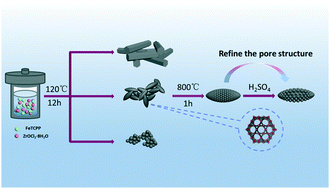We report the size and morphology-controlled synthesis of PCN-222 crystals, a class of zirconium-based iron porphyrinic coordination networks, and their pyrolytic derivation of hierarchically porous Fe–N–C electrocatalysts for the oxygen reduction reaction (ORR). By optimizing precursor concentrations, nanometer-scaled and spindle-shaped PCN-222 crystals are obtained through a solvothermal method. A NaCl salt-assisted pyrolysis is employed to convert the PCN-222 crystals to an Fe–N–C catalyst, so as to inherit the nanospindle morphology and the Fe–N coordination structure in the PCN precursor, and at the same time to increase the graphitization degree. A post-activation procedure using concentrated sulfuric acid is further designed to induce a controlled NaCl removal and carbon etching process that optimizes the porous structures and surface properties of the final nanospindle Fe–N–C catalyst. The reaction between the concentrated sulfuric acid and NaCl produces heat to activate acid etching of carbon, and on the other hand consumes the acid to prevent the carbon from over-etching. The unique nanospindle shape and hierarchically porous structure allow efficient exposure of the high-density active sites and their accessibility to reactants, while the high degree of graphitization ensures efficient conduction of electrons involved in the electrocatalytic reaction and good stability of the carbon matrix during the electrocatalytic processes. Based on the results, the as-prepared Fe–N–C catalyst exhibits remarkable ORR performance, with a half-wave potential that is ca. 30 mV more positive than that of the state-of-the-art Pt catalyst, and excellent stability in alkaline solution, as well as an ORR activity comparable to Pt in acid solution.
https://doi.org/10.1039/C8CY00168E
